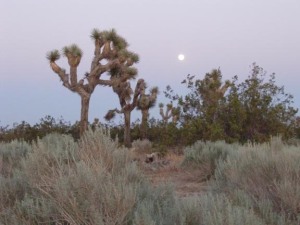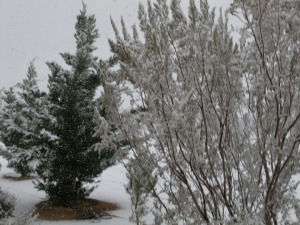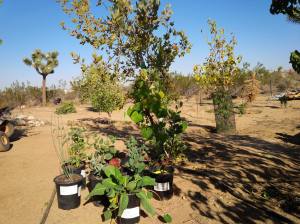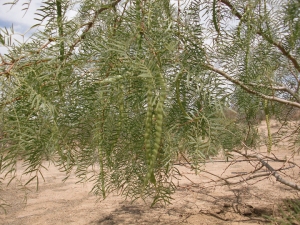We need more of a windbreak. We need trees planted across the line of the prevailing southwestern winds. It’s the high desert so the winds, in fact, can come from the four directions on four different days. The desert growth (Joshua, juniper, and creosote bush) tempers the wind when it come from the east and somewhat from the north.
On the old farm we had windbreak on three sides of the house and the orchard area on the north. That wasn’t my smartest desert farming move, but the trees all flourished in spite of me. The orchard here has a greater variety of trees, though, not just apples and pears. And the winds here are very much consistently stronger. I don’t know if the stronger and more persistent winds here are a result of climate change in the high desert or our location relative to the Cajon Pass. Most likely, both.
In severe weather like high desert winters (or summers or springs or fall), trees and shrubs as windbreaks can protect food plants (in and outside of plastic covers) in hot and cold weather, can cut utility bills, help control erosion, and provide wildlife habitat. Additionally, windbreaks add to the beauty of farm land and contribute to biodiversity.
Here are some of my thoughts about windbreaks in the southern Mojave Desert:
- Dryland pines
- Jujubes (maybe not dense enough by themselves)
- California junipers (I’ve ordered some from
- Arizona cypresses ( also native to southern California, I hear)
- Persimmons (have been used in parts of China as windbreaks)
- Leyland cypress
At the old farm, I used Leyland cypress and they were excellent. They also are a much better habitat for local birds than we tend to think. I had a barn owl (rodent control) living in one for a few years, right before we moved.
I’m currently experimenting with all of the above and they all are doing very well in this ecoregion. The ground squirrels like eating the leaves off the persimmon a little too much, so maybe that’s not the best choice for right now.
I really like the idea of a two-layered windbreak. Whatever I choose for windbreak trees, I’d like to place a second layer of large shrubs inside the perimeter of taller trees. For the second layer I like the idea of manzanita, Lycium spp., chokecherries, and/or mesquite. Really, any shrubby fruit tree would be great for the inside layer. Biointensive and tasty.
This summer when I met one of my neighbors down the road for the first time, after about five minutes of conversation, he asked me “Are you one of those tree-hugger eco-freak types?” Eco-freak, yep. Tree-hugger, absolutely.
Tags: agroecology, mojave desert, native plants, socioecological intelligences, sustainable agriculture, windbreak trees, women farming




Leave a comment